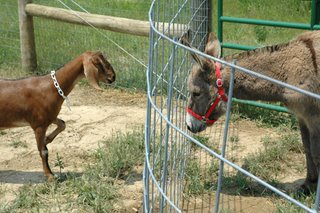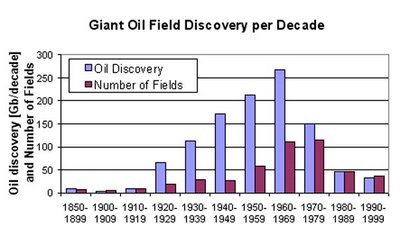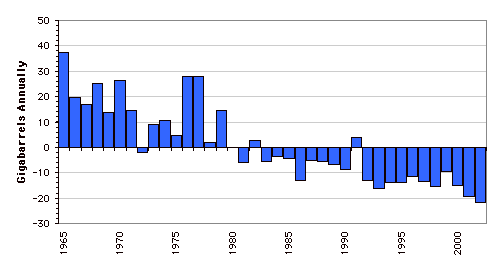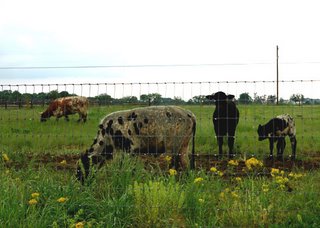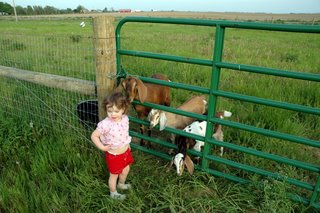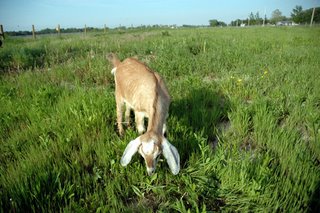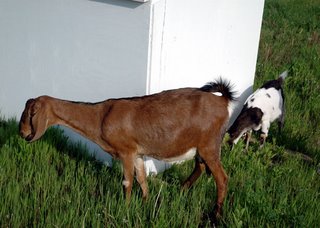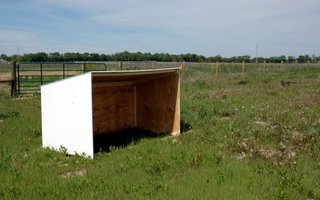Calendar Shuffle, part two
Well, now that we're done with a belated March, we've skipped ahead to August. It has been in the mid-90's for days now. Not the best time to be putting in new fencing. Not the best time to be building a storage shed. Not the best time to be a shaggy donkey. And definitely not the best time to be running errands in an old, unreliable pickup truck, with no air conditioning and windows that don't roll down.
On the way to pick up a few cattle panels first thing this morning ("I'll get up early and beat the heat!") the truck stalled about once per mile. On the way back, it stalled about once per quarter mile, and finally gave up about halfway home. During the morning rush hour. At the end of an exit ramp.
While waiting for the tow truck to arrive, I entertained myself by sitting in the shade of an abandoned service station, and watching as drivers came up behind the truck and had to make a tough decision as to whether they should cross the double yellow line or drive on the (curbless) sidewalk to get around. (The pickup couldn't easily be moved out of the way.) It was running about 50/50 between around to the left and around to the right. Interestingly, whether the cars were eventually turning right or left didn't seem to affect their decision. Many went around the left side of the truck in order to turn right, and vice versa. A few just sat behind the truck for a few minutes, totally stumped. Eventually they got up the gumption to go around, but it apparently took some mental preparation. (Yes, it did take a long time for the tow truck to arrive. How'd you guess??)
I don't know if the truck will be with us much longer. It has at least three significant problems, and at least two of them are not easily solved. The frequent stalling is new. It may be heat related, or it may just be it's last gasps. The fact that I'm pretty much a novice when it comes to vehicle repair doesn't help. So now we start getting into those difficult decisions of whether to throw more money into this pit, or to find a slightly better pit to throw a new stack of money into. Especially since we've put most of our extra money into everything else already. And I certainly don't want to create any new debt.
Unfortunately, we'd be hard pressed to keep our little farmlet operating without a truck of some sort. The one we have gets used pretty infrequently, maybe once every week or two, but when we do need it, we actually need it. It's hard to transport things like cattle panels, plywood, hay, straw, tractor implements, etc. without it. I think once we have our winter animal housing taken care of, it will be needed less than now, but we've still got some necessary projects to complete. And there are a million uses for a pickup truck when you live far away from everything. There's a reason you see so many pickup trucks out in the country, and it's actually not just aesthetics. Anyway, we have a dilemma to work out.
The worst part was that because of that morning delay, I was pounding t-posts into the ground with a sledge hammer at mid-day to build a temporary fence to separate our donkey from the goats until they could acclimated. Jinx arrived before I got the fence done, so he just stayed in our little "air lock" by the gate while I finished the fence. By the time I got done, I had an eight inch gap in the fence and nothing handy to cover it with. I was dehydrated. The heat was slowing me down. One of the shelters still needed to be dragged to the other pasture so he'd have some shade. At that point I realized that the goats and the donkey had absolutely no ill feelings toward one another, and acres of pasture to distance themselves in if they so desired. It was a precaution worth taking, but the toiling feels a bit wasted now.
It was a long day. Especially when you start drenched in sweat before 8:00 in the morning, and end drenched in sweat again (or still) after 9:00 at night. (I was out in the garden after sunset tonight. I have an abundance of tomato plants and pepper plants. More survived indoors than I expected, and I just can't throw away a perfectly good plant. Especially one that bears tasty fruits.)
I hope we get a break from the heat soon. I'm really not ready for high summer yet...

